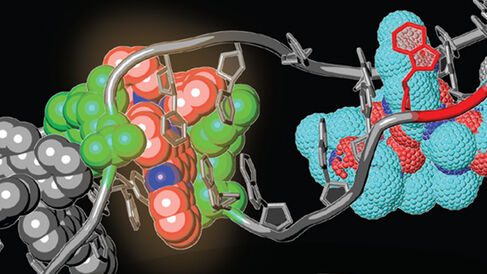
Professor Michael Waring has edited a new book, published by the Royal Society of Chemistry, entitled "DNA-targeting molecules as therapeutic agents".
This new book explains key aspects of the remarkable progress that has been made towards understanding how drugs can bind specifically to nucleic acids; processes which underpin the endeavour to make gene targeting a reality. The binding of drugs to DNA is a fast developing area of research with important applications in medicine, particularly for the treatment of cancer. Throughout the book, the role played by chemistry is a unifying theme. Early chapters cover methodologies to evaluate DNA-interactive agents, with examples of DNA-binding molecules and technologies in development as therapeutic agents. DNA-binding metal complexes, peptide and polyamide-DNA interactions, and gene targeting tools are among the most compelling topics covered in depth.
At the start of Professor Waring's research career, the structure of the DNA double helix had been known for less than a decade and was widely criticised. It was obvious, however, to Michael that understanding the molecular characteristics of DNA would revolutionise the life sciences. As such, Michael jumped straight in to the study of nucleic acids during his PhD in Ernest Gale's group at the Microbiology Unit on the top floor of the Hopkins building, where he investigated microbial metabolism to identify the targets of antibiotics. Specifically, Michael focused on actinomycin D, an antibiotic known to interfere with DNA functions, finding that it acts through inhibiting RNA polymerase to block RNA synthesis. As the techniques to purify RNA polymerase had only just been published, Michael set out to discover further biomolecules that affect DNA as well as this essential enzyme. Of the various compounds he identified, the mutagenic acridines are particularly interesting as these were widely used as stains in histology as well as offering some protection against diseases. As part of Michael's efforts to characterise molecules that interfere with nucleic acids, he developed novel techniques to study their binding to DNA, and was one of the first researchers to show ethidium bromide is a DNA intercalating agent, eventually leading to its widespread use for staining DNA gels. He also identified the antibiotic now known as doxorubicin as a powerful intercalator; it is routinely used in most cocktails to treat major forms of cancer all over the world, saving millions of lives.
After a one-year postdoc in Washington D.C. at the Carnegie Institution Department of Terrestrial Magnetism where he discovered the existence of repeated sequences in the DNA of higher organisms in collaboration with Roy Britten, Michael returned to Cambridge and continued to focus on DNA-targeting molecules that distort its structure and function for his entire career, and is now Emeritus Professor of Chemotherapy at the University of Cambridge. He was the first to show that intercalation by ethidium removes and reverses DNA supercoiling, after which he discovered the phenomenon of bis-intercalation by echinomycin and diacridines. His lab was one of three that simultaneously developed footprinting to determine ligand-binding sites on DNA, and went on to investigate the kinetics of binding as well as methods for making new antibiotics by directed biosynthesis. He also established the critical role of the 2-amino group of guanine in sequence recognition by small (and some large) molecules, and pioneered the use of atomic force microscopy to study the binding of drugs to DNA.
Outside of science, Michael was an assistant organ scholar at Downing College and is currently Senior Treasurer of the Jesus College Boat Club. He also enjoys travelling and holds a commercial pilot licence.
